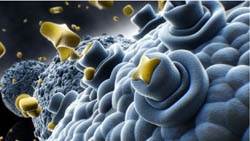Sweet bionic smell of success
Recently, major advances in odour-sensing technology and artificial intelligence have stimulated a renewed interest in the use of smell – olfaction – in different fields. While existing electronic nose devices can detect and identify some odorants, they do not meet all of the requirements for many of the potential applications. During the EU's Fifth Framework Programme (FP5), the SPOT-NOSED project developed a new approach for electronic noses by using olfactory receptors (ORs), the proteins responsible for the detection of odors in most animals, as the sensing elements. Based on this new concept, the EU-funded 'Bioelectronic olfactory neuron device' (BOND) project was established. BOND's objective was to develop a new generation of bioelectronic nose devices relying on the amazing analytical properties of the mammalian nose: specificity, sensitivity, identification of mixed signatures and real-time response. The project set out to develop an array of smart nanobiosensors containing a large number of different ORs for the detection of odorant signatures. Initially, the project developed and integrated the main technologies and components of the new bioelectronic analytical platform before assembling the first complete prototype. Then, preliminary tests of the prototype were carried out in order to validate this new technology for a target application in the area of food quality. The completed project has successfully developed and produced a nanobiosensor able to monitor the presence and measure the concentration of specific odorants. The potential for the novel electronic nose covers many different fields and uses, including medical applications, where it could drastically reduce the cost of diagnosing and monitoring disease. The new sensor will be also able to detect contaminated food products rapidly and accurately before they are sold, thus helping to ensure the safety and quality of food consumed in Europe. For more information please see: http://www.bondproject.org(opens in new window)







